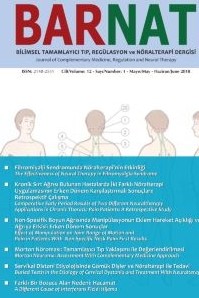FASYA FONKSİYONLARI, İŞLEVSEL GÖREVLERİ VE NÖRALTERAPİ YAKLAŞIMI
Lokomotor sistem başta olmak üzere tüm organsal disfonksiyonların özellikle kronik hastalıkların çoğu fonksiyonel kökenlidir. Fasya zengin sempatik inervasyonu ile postür ve hareket kabiliyetinin yapısal bileşeni, destek birimi ve çerçeve çatı sistemidir. Fasya sistemi fonksiyonel kökenin anlaşılması ve bağlantıları ile bedenin bütünlüğünün değerlendirilebilmesi için önemlidir. Nöralterapi fasyal disfonsiyonlarda perfüzyon artışı, innervasyon regülasyonu, lenfatik drenaj etkisi ile hızlı, etkin ve kalıcı tedavi imkanı sağlar.
Anahtar Kelimeler:
Fasya, bağ dokusu, locomotor system, nöralterapi, fasya zinciri
FASCIA FUNCTIONS, FUNCTIONAL TASKS AND NEURALTHERAPY APPROACH
Most of the functional dysfunctions, the locomotor system, especially the chronic diseases have functional origins. Fasia is a structural component, support unit and frame roof system of postural and mobility with rich sympathetic innervation. The fascial system is important for understanding functional origins and for linking and evaluating the integrity of the body. Neural therapies provide a faster, effective and permanent treatment with enhanced perfusion, innervation regulation and lymphatic drainage effect in fascial dysfunctions
Keywords:
Fascia, connective tissue, locomotor system, neural therapy, fascia chain,
___
- Thomas W. Myers, “Anatomy Trains”, Elsevier 2016
- H. Nazlikul. Nöralterapi- Nörofizyoloji, Temel Sistem, Bozucu alan, VSS – Nobel 2010
- A. Pischinger. “The Extracelluler Matrix and Ground Regulation”, Hardco- ver – July 17, 2007
- T. Acarkan. Bağ Dokusu ve Temel Madde BARNAT 13-Haziran 2011
- Carla Stecco, “Functional Atlas of the Fascial System”, Elsevier 2015
- Serga Paoletti, The Fascia,”Dysfunction and Treatment”, American Book Publishing, 2009
- T. Acarkan. 13. Geleneksel Herget Tamamlayıcı Tıp ve Nöralterapi Sem- pozyumu sunumu, 2017
- R. Schleip. Der aufrechte Mensch, Keıner 2017
- R. Schleip et Kolegen. Lehrbuch Faszien – Grundlagen- Forschung – Be- handlungen, Urban & Fischer 2014
- Bordoni B, Zanier E. Understanding Fibroblasts in Order to Comp- rehend the Osteopathic Treatment of the Fascia. Evidence-based Complementary and Alternative Medicine eCAM. 2015; 2015:860934. doi:10.1155/2015/860934.
- H. Nazlıkul. Tedaviye Dirençli Durumlarda Bozucu Alan Ve Bozucu Odak Kaynaklı Klinik Ve Tanı Refleks Kaynaklı Olan Durumlarda Reviquant De- nilen HRV Sisteminde Faydalanmak- BARNAT
- Y. Bai, J. Wang et al. Review of Evidence Suggesting that the Skin Fascia Network Could be the Anatomical Basis for Acupoints and Meridians in the Human Body. Evidence-Based Complemantary and Alternativr Medi- cine. Hindawi Publising Corporation. Vol 2011, Article ID 260510 6 pages
- S. Rein, S. Manthey et al. Distribution of Sensory Nerve Endings Around the Human Sinus Tarsi: A Cadaver Study. J. Anat. (2014) 224. pp 499-508
- H.C. Hsu, N. Y. Tang et al. Effect of Electroacupuncture On Rats with Chro- nic Constriction Injury-Induced Neutropathic Pain, Hindawi Publisng Corporation The Scientific World Journal Vol 2014 ID 129875 9 pages
- W. Gibson, L.A. Nielson et al. Increased Pain from Muscle Fascia Fol- lowing Eccentric Exercise: Animal and Human Findings Exp Brain Res (2009) 194:299-308
- P.J. Albrecht et al. Excessive Peptidergic Sensory Innervation of Cutaneo- us Arteriole-Venule Shunts (AVS) in the Palmar Glabrous Skin of Fibrom- yalgia Patiens Pain Med.2013:14,895-915
- J. Tesarz, U.Hoheisel et al. Sensory Innervation of the Thoracolumbar Fascia in Rats and Humans Neuroscience 194 (2011) 302-308
- U. Hoheseil, J.Rosner et al. Innervation Changes Induced by Inflammati- on of the Rat Thorocolumbar Fascia Neuroscience 300 (2015) 351-359
- F.H. Willard, A.V. leeming et al. The thorolumbar fascia: anatomy, functi- on and clinical considerations J. Anat (2012) 221.pp507-536
- ISSN: 2148-2551
- Başlangıç: 2006
- Yayıncı: Bilimsel Nöralterapi ve Regülasyon Derneği
Sayıdaki Diğer Makaleler
YARA İYİLEŞMESİNDE BAĞ DOKUSUNUN YERİ VE NÖRALTERAPİ YAKLAŞIMI
ÜLSERATİF KOLİT’Lİ BİR HASTANIN NÖRALTERAPİ VE DİĞER KOMPLEMENTER TEDAVİLER İLE TAKİBİ
FONKSİYONEL VE DEJENERATİF BEL ŞİKAYETLERİNDE NÖRALTERAPİ VE MANUEL TIP YAKLAŞIMI
Neslihan ÖZKAN, Hüseyin NAZLIKUL
ORTOMOLEKÜLER TIP YAKLAŞIMIYLA MAGNEZYUM TAKVİYELERİ
FASYA FONKSİYONLARI, İŞLEVSEL GÖREVLERİ VE NÖRALTERAPİ YAKLAŞIMI
